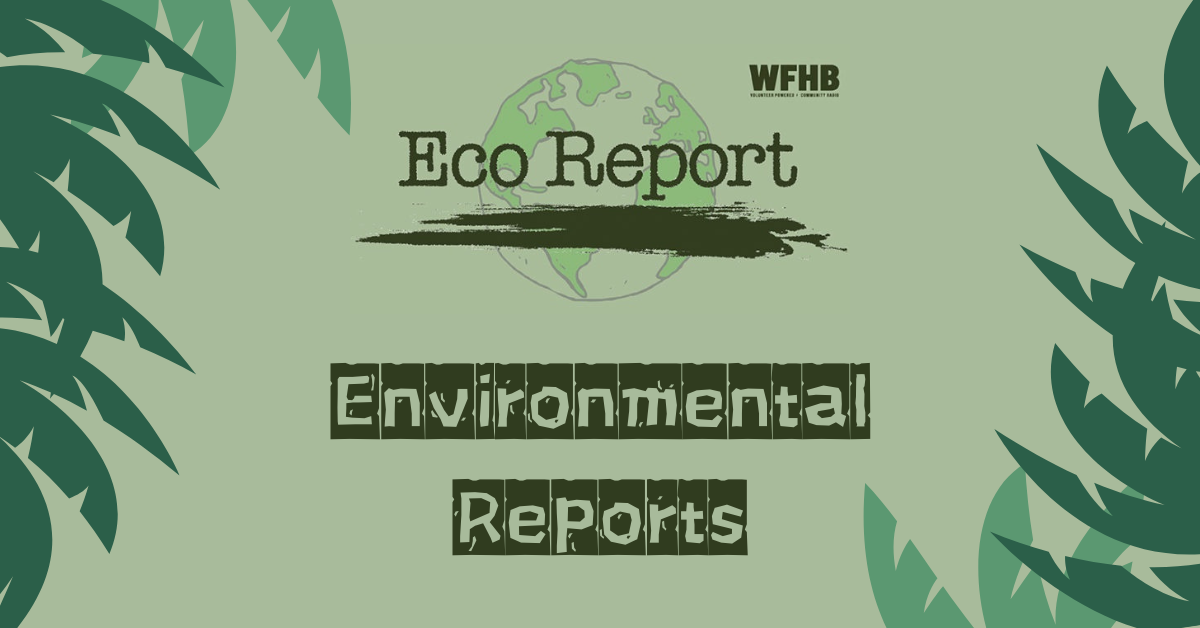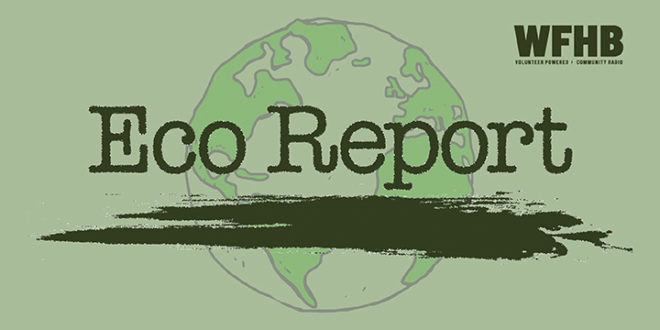Podcast: Play in new window | Download (Duration: 30:26 — 69.7MB)
In this edition of Eco Report, Kade Young and Noelle Herhusky-Schneider continue their conversation with Maggie Sullivan, the Watershed Coordinator for the Friends of Lake Monroe, discussing the history of the lake and its crucial role in the Bloomington water supply.

Eight percent of Indiana’s corn and soybeans have been planted across the state according to USDA. That compares to two percent of both corn and soybeans planted from last week’s report. Planting progress for both corn and soybeans are below their respective five-year averages at 13 and 9 percent. The statewide average precipitation was 0.80 inches, 0.02 inches below normal. There were 3.8 days suitable for fieldwork for the week ending April 28, according to Nathanial Warenski, State Statistician, Indiana Field Office. Winter wheat jointing for Indiana is at 61 percent compared to 43 percent from last week. Seven percent is headed.
The planting so far does not reflect any adjustment for the possibility of a La Nina this summer. The Progressive Farmer says “with La Nina indicated to form by mid to late summer, there is a notable potential decline in corn production from levels posted in USDA’s 2024 Outlook Forum. The Outlook Forum projected U.S. corn production at 15.04 billion bushels in 2024”. During the last La Nina event 2011-2012, U.S. corn growers produced 10.8 billion bushels in 2012, 13 percent below the 2011 crop. Many Indiana farmers lost most of their crop in 2012. Some states in the Corn Belt did not suffer excessive drought.
You may not see many monarch butterflies this summer. Why? There are very few left. EcoWatch reports the estimated number of monarch butterflies migrating to Mexico for winter has reached its second-lowest level ever for the 2023 to 2024 overwintering season. The estimate, based on the size of the butterflies’ hibernating forest area, has dropped by about 59% from the previous year, according to officials. Experts are pointing to extensive heat and drought as well as climate change for the major decline. Recent years have seen some hope for the migrating monarch butterflies, with a 35% increase in the number of butterflies observed overwintering in Mexico during the 2021 to 2022 season compared to the previous year.
But monarch butterflies face three primary threats, including habitat loss for their breeding and overwintering; the use of pesticides, which can be toxic to the butterflies or can kill their food source, milkweed; and climate change, which can shift their migratory patterns. By the 2022 to 2023 overwintering season, World Wildlife Fund reported a 22% drop in the amount of overwintering monarch butterflies in Mexico. According to WWF, monarch butterflies once covered about 45 acres of forested land in Mexico during their 1996 to 1997 overwintering season. Last year, they covered 5.5 acres. With the 59% decline, the 2023 overwintering season saw the butterflies covering just 2.2 acres, The Associated Press reported. The lowest coverage ever recorded was 1.65 acres from 2013 to 2014.
Inside Climate Change reports that power plant pollution is targeted in sweeping actions by the Biden Administration. Greenhouse gas rules offer a leeway, but come packaged with new standards for air, water and waste that put big restraints on coal. The EPA has set the most stringent standards for the coal plants that are going to last the longest, and the gas plants that are going to operate the most often, said Frank Sturges, attorney with the advocacy group Clean Air Task Force.
This means there are going to be meaningful reductions that help address the worst impacts of climate change. The Department of Energy finalized a pair of measures designed to speed the build-out of renewable energy: a long-awaited plan to accelerate the federal permitting process for big transmission line projects and a streamlined environmental review process for upgrades of existing transmission lines, battery and other energy storage systems and solar photovoltaic projects.
CNN reports more people across the United States – nearly 40% – are living in places with unhealthy levels of polluted air, according to a new report from the American Lung Association. The number of people living with levels of air pollution that can significantly affect their health climbed from about 119 million in last year’s data to 131 million in the current data, according to the “State of the Air” report released Wednesday. Extreme heat, drought and wildfires are among the factors that have contributed to a rise in deadly air pollution, especially in the Western part of the country, said Katherine Pruitt, author of the report and senior director of the American Lung Association’s Nationwide Clean Air Policy. The air pollution produced by wildfire smoke is getting worse every year, Pruitt said.
Climate change is contributing to that situation, and those wildfires are a very serious threat to our health. According to a report by WFIU, Indianapolis is among one of the worst cities in the country for particle pollution. Particle pollution refers to a mix of solid and liquid droplets in the air – from things like burning stoves or smokestacks – which are harmful to breathe in. The 2023 “State of the Air” report from the American Lung Association ranked Indianapolis as the 10th most polluted city for year-round particle pollution.
The city was ranked 13th last year. Tiffany Nichols is the Indiana advocacy director for the American Lung Association. She said Marion County received an “F” in the organization’s State of the Air report for particle pollution, meaning people may experience new or worsening lung issues due to air quality. There will be more wheezing and coughing, shortness of breath, asthma attacks may be exacerbated, worsening of COPD, lung cancer, she said. Some other less common things are premature death. Heart attack and stroke and more susceptibility to infections.

In this weeks feature, Kade Young and Noelle Herhusky-Schneider continue their conversation with Maggie Sullivan, the Watershed Coordinator for the Friends of Monroe Lake, discussing the history of the lake and its crucial role in the Bloomington water supply.

- Growing Gardeners, a program offered by the City of Bloomington Parks and Recreation, will offer hands-on garden related project ideas that will help inspire kids to get involved with gardening on Saturday, May 4th, at the Willie Street Community Gardens from 10 am to Noon. Sign up at bloomington.IN.gov/parks.
- Enjoy a Cold Blooded Buffet at McCormick’s Creek State Park on Sunday, May 5th, from 2 to 2:30 pm in the Nature Center. Hop and slither to see the resident reptiles chow down on bugs and mice. Learn cool facts about Indiana’s native amphibians and reptiles.
- The popular Flora Field Day at the Salt Creek Recreation Area at Monroe Lake is scheduled for Tuesday, May 7th, from 9:30 to 11:30 am. Work on your flora identification skills with the naturalist. Bring bug spray, water, hats and sunglasses and a copy of Newcomb’s Wildflower Guide. Sign up at tinyurl.com/florafield-may2024.
- Help maintain habitat from invasive species on Wednesday, May 8th, from 10 am to Noon at the Porter West Preserve. Sycamore Land trust needs volunteers to Weed Wrangle and learn about garlic mustard. RSVP to Sycamorelandtrust.org.
- Take a Wildflower Hike at McCormick’s Creek State Park on Sunday, May 12th, at 4 pm. Meet the naturalist Jessica at the Canyon Inn to enjoy a hike on Trail 4 as you learn about spring-blooming wildflowers.
Credits:
On Air…………………..Julianna Dailey
On Air………………….Robert Schull
Headlines……………..Norm Holy
News feature…………Kade Young
Script…………………..Julianna Dailey
Events Calendar………Julianna Dailey
Producer………………Kade Young
Producer………………Noelle Herhusky-Schneider
Engineer………………Branden Blewett
Are you looking for a way to make a difference on environmental issues?
EcoReport is looking for reporters, engineers, and segment producer to report facts on how we’re all affected by global climate disruption and the ongoing assaults on our air, land and water. We also celebrate ecologists, tree huggers, soil builders and other champions who actively protect and restore our natural world, particularly those who are active in south central Indiana. All levels of experience and all ages are welcome, and we provide the training you’ll need. WFHB also offers internships. To volunteer for Eco Report, call at (812) 323-1200, or e-mail [email protected].
 WFHB Bloomington Community Radio
WFHB Bloomington Community Radio


